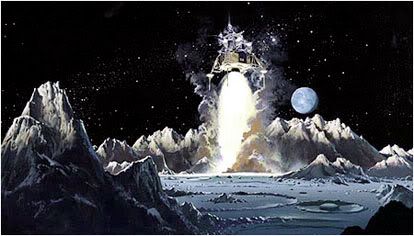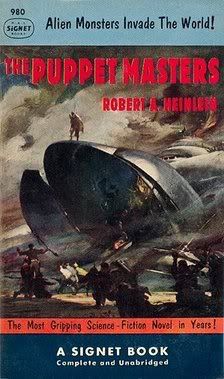
Thumbnails: 30 Second Interviews
Vincent Di Fate’ s accomplishments are too many and too varied to be listed here -- he is, remarkably, equally gifted as an artist, teacher, and historian. For a full and fascinating biography, you should visit his website. If you have any interest in science fiction art and do not own is art book, The Science Fiction Art of Vincent Di Fate, and his survey of science fiction artists, Infinite Worlds, than you are better off leaving right now to obtain them.
What is your favorite painting in the last year?
Almost anything by Justin Sweet. This is one truly fabulous talent, from what I've seen so far.
What is your dream assignment?
Some years ago (late '70s, early '80s) I got the assignment to illustrate the covers for Signet's series of novels and story collections by Robert A. Heinlein. I grew up reading those books and loved the idea of creating new cover art for them. The series was acquired by some other softcover publisher before I got to the really great novels--The Puppet Masters, Double Star and The Door Into Summer.
Painting you wished you painted?
Gosh, there are so many. This is a question with two possible perspectives:
(1) the paintings I wished I'd painted that were really done by others and;
(2) assignments I wish I'd gotten, but nobody ever asked me.
The answer to the first one is that I wish I could have painted Meltzoff's original cover art for The Puppet Masters--in my opinion, the genre's one true masterpiece. Of course, I was only seven in 1953 when it was done, but I couldn't paint something that good even now, at age sixty.
The second answer is, anything by Verne, Wells, Heinlein, Clarke or Wyndham. Clarke is easily the most fun to visualize, but any of these authors are great to illustrate. I've done Wells' The War of the Worlds at least twice (my favorite novel), but hope to get that assignment at least a few more times before I die. Maybe I'll get it right...
First break in the business?
My first break was also the first and only time I ever got fired. Nearly fresh out of art school, I was working for Krantz Films on the ABC-TV animated superhero series Spider-Man first as a background artist, then as an in-betweener (assistant animator). I'd been "kicked upstairs" when they learned I could draw and my job was mainly to take the animators' drawings, correct the anatomy, merge the styles into one consistent look, then do the in-betweens (the motion drawings between the specific start and stop positions).
Long story short, the show was attacked in a brutalizing editorial in The New York Times that claimed we were scaring kids out of their toilet training because of the violence in our show. That editorial appeared on a Sunday. Monday morning most of the staff was let go, including me.
That was a week or two before Thanksgiving, 1968. I was technically still in the Navy then (this was during the Vietnam era), but in late March my wife of about two weeks had been diagnosed with terminal cancer and given just three months to live. While I awaited formal discharge from military service on the grounds of humanitarian hardship, and my wife, Roseanne, somehow clung to life, I'd gotten the gig at Krantz Films. Steve Krantz, our producer, is married to best-selling author Judith Krantz, and has since written a few best-sellers of his own. Our director, Ralph Bakshi, has been variously described as a demon and a saint. I personally think demon is more apt. I could have begged for my job back and stuck it out for a few months if they'd have known about my personal situation, but it was a matter of pride with me. Spider-Man was not immediately cancelled; its funding was pared to the bone by ABC and the studio was allowed to finish out the season, provided that it "cleaned-up" the show.
The upshot was that I figured I'd try my hand at freelance while I waited to find gainful employment elsewhere. I went up to Analog during the week between Christmas of 1968 and New Years, and walked away with two manuscripts under my arm from the legendary John W. Campbell, Jr. Campbell was the first editor to take my work seriously and to give me enough freelance to keep me busy. And that was the beginning. Campbell gave me 75 assignment in that first year, and I never looked back.
The good news is that Ro's still alive after nearly 40 years and is in reasonably good health, under the circumstances. She had an advanced stage of Hodgkin's Disease, considered terminal then, and for seven long, grim years we lived life day-by-day. The other good news is that I was sucessful at illustration, though I seldom give myself the luxury ofappreciating my success.
Most embarrassing illustration related moment?
So many...
Early in my career I went to the Huntington Hartford Museum (then housed in that goreous building at Broadway and 59th St.) with an art director, who was into some pretty exotic contemporary art. After walking through endless rooms of crumpled craft paper and piles of sand, we finally came upon an exhibit made up of old shoes. In that odd light of the museum the shoes looked to me like they might have been made of wax or soft fabric, and I started praising the exhibit to my companion, noting how some of the laces were still tied and that all of the bows were uneven, showing a distinct consciousness of composition. After going on for several minutes about this fantastic artistic achievement, I leaned over to read the sign and it said: "Please remove your shoes before going into the next exhibit.”
A career highlight?
For me, my entire career has been a reaffirmation of my total lack of talent. Every painting is, in the end, a crushing let down. The career highlight is ongoing and it centers around the fact that few people have ever figured out how bad I truly am.
Tuesday, August 08, 2006
Thumbnails: Vincent Di Fate
Labels: Interviews
Subscribe to:
Post Comments (Atom)


3 comments:
I guess the difference between illustration and fine art is that illustrators create masterpieces and think they're crap and fine artists create crap and think they are masterpieces.
Good one, Arkady!
"Only when he no longer knows what he is doing does the painter do good things." ~ Edgar Degas
As a former student of DiFate I must say, without his 'never ending' knowledge of the arts , what would have taken me years of sleepless nights locked in my studio with my paints and brushes to understand, he has helped me to see in the few years as his pupil.
Post a Comment